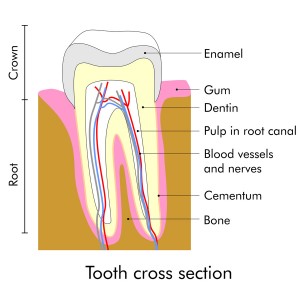
Oral bacteria attack the dentin once the gums start to recede.
If you’re battling periodontal (gum) disease, you may be interested to know that this condition affects millions of Americans. According to research published by the Centers for Disease Control and Prevention (CDC), almost half of the U.S. population aged 30 and above has experienced mild, moderate, or severe periodontitis.
The good news is, periodontal disease is very treatable, and in many cases, entirely reversible. So what type of treatment can you expect at Rock Creek Dental?
Goals of Treatment
When treating gum disease, we aim to do the following:
- Reduce swelling of the gums
- Thoroughly clean and reduce the pockets between teeth and gums
- Prevent damage to surrounding bone
- Stop the disease from progressing further and reduce risk of infection
- Assist gums to return to health, then promote reattachment of gums to the teeth
Depending on various factors including the current stage of the disease, your personal medical history, and your body’s response to treatment, your dentist may use a variety of methods of therapy, including both surgical and nonsurgical options.
Nonsurgical Treatment
If your periodontitis is in the early to moderate stage, your dentist may opt for one of the following treatments:
Professional cleaning: Using special tools, your dentist will remove plaque and tartar from around your gums. This process may be repeated more frequently than typical in an effort to reverse the effects of the disease.
Scaling: Using a different set of special instruments, your dentist conducts a deeper cleaning that removes tartar and bacteria from your tooth surfaces and beneath your gums. You will receive a local anesthetic before undergoing this procedure.
Root planing: Your dentist works at smoothing out the surfaces of your tooth roots, providing an ideal surface to which gums may reattach.
Antibiotics: A regimen of topical or oral antibiotics is prescribed in an effort to control or eliminate the infection causing bacteria.
Surgery
Once periodontitis has advanced, your gum tissue may only respond to surgical treatment. In this case, your dentist will often refer you to a periodontist, a dentist who specializes in the prevention, diagnosis, and treatment of periodontal disease.
Periodontists are especially skilled in the following treatment options:
Flap surgery/pocket reduction surgery: In this procedure, your dentist will make tiny incisions, making it possible to “lift” the gums and more effectively use scaling and planing to remove tartar. Afterwards, the periodontist may reshape the tooth so that the gum fits more snugly around it. After the gum is sutured into place, the area where harmful bacteria can grow is drastically reduced.
Bone grafting: In some cases, infection has destroyed some of the bone surrounding your tooth. Your dentist may recommend replacing this bone. To accomplish this, your dentist may use a piece of your own bone. Donated or synthetic bone may also be used. Using the new bone as a platform, your body will eventually begin regenerating bone and tissue on its own.
Soft tissue grafting: If the gums have become very thin or have receded, soft tissue may be taken from the roof of your mouth, then reattached to the gums to strengthen them and/or fill them out.
This is just a sample of the methods available to your dentist. Your dentist may wish to discuss other techniques and treatments to deal with your specific circumstances.
Procedure and Recovery
If you suspect that you’re suffering from gum disease, let’s start the healing process! Contact us today and we’ll set up an appointment as soon as possible.